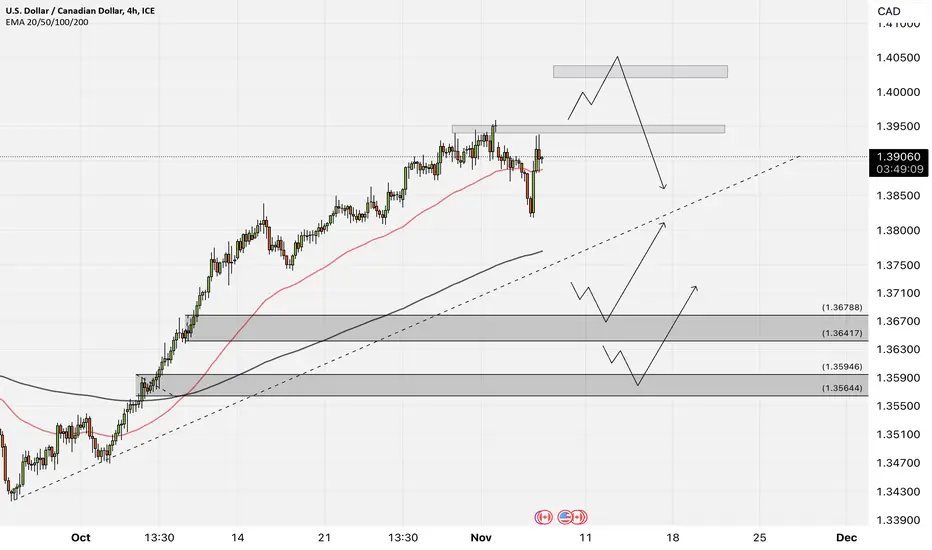The USDCAD currency pair is above the EMA200 and EMA50 in the 4H timeframe and is moving in its medium-term bullish channel. If the upward movement continues, we can see the supply zone and sell within that range with the appropriate risk reward. The correction of this currency pair towards the demand zones will provide us with the next buying positions.
Following the announcement of Donald Trump’s election victory, the U.S. dollar has risen against almost every currency globally. Markets are not only preparing for Trump’s presidential win but also foresee a Republican-controlled Congress, which is crucial for the incoming president’s ability to implement policy changes through the U.S. government.
Ahead of the October 23 monetary policy meeting, officials at the Bank of Canada believed that inflationary pressures were on a downward trend and further tightening of monetary policy was unnecessary. They considered a 0.25% rate cut, though strong consensus emerged for holding off based on economic data observed since July.
Officials noted that a rate cut would require time to sufficiently impact per capita consumer spending and counterbalance the overall consumption decline driven by slower population growth. They agreed to continue normalizing their balance sheet through maturing bonds.
According to informed sources, OPEC+ has reached a preliminary agreement to postpone an increase in oil production for December. This agreement includes countries such as Saudi Arabia, Russia, Iraq, the UAE, Kuwait, Kazakhstan, Algeria, and Oman, which have decided to extend their voluntary oil production adjustments until the end of December 2024.
One key factor weakening the Canadian dollar is the country’s economic challenges. The Canadian housing market is facing serious difficulties due to rising interest rates, and the decline in demand for new home purchases has dimmed future prospects for the market. Additionally, slower population growth, largely dependent on government immigration policies, is negatively impacting the economy. Nonetheless, some hope that China’s economic stimulus efforts and rising natural commodity prices might support the Canadian dollar, though these factors carry their own risks.
BlackRock has stated that expectations for a Federal Reserve rate cut are overly optimistic. The bank cited the following reasons:
U.S. third-quarter GDP data show that consumers remain the main driver of economic growth. The average monthly job creation over the past three months has been 104,000 jobs, a healthy rate, which is likely to rise considering hiring pauses due to storm disruptions.
Following the announcement of Donald Trump’s election victory, the U.S. dollar has risen against almost every currency globally. Markets are not only preparing for Trump’s presidential win but also foresee a Republican-controlled Congress, which is crucial for the incoming president’s ability to implement policy changes through the U.S. government.
Ahead of the October 23 monetary policy meeting, officials at the Bank of Canada believed that inflationary pressures were on a downward trend and further tightening of monetary policy was unnecessary. They considered a 0.25% rate cut, though strong consensus emerged for holding off based on economic data observed since July.
Officials noted that a rate cut would require time to sufficiently impact per capita consumer spending and counterbalance the overall consumption decline driven by slower population growth. They agreed to continue normalizing their balance sheet through maturing bonds.
According to informed sources, OPEC+ has reached a preliminary agreement to postpone an increase in oil production for December. This agreement includes countries such as Saudi Arabia, Russia, Iraq, the UAE, Kuwait, Kazakhstan, Algeria, and Oman, which have decided to extend their voluntary oil production adjustments until the end of December 2024.
One key factor weakening the Canadian dollar is the country’s economic challenges. The Canadian housing market is facing serious difficulties due to rising interest rates, and the decline in demand for new home purchases has dimmed future prospects for the market. Additionally, slower population growth, largely dependent on government immigration policies, is negatively impacting the economy. Nonetheless, some hope that China’s economic stimulus efforts and rising natural commodity prices might support the Canadian dollar, though these factors carry their own risks.
BlackRock has stated that expectations for a Federal Reserve rate cut are overly optimistic. The bank cited the following reasons:
U.S. third-quarter GDP data show that consumers remain the main driver of economic growth. The average monthly job creation over the past three months has been 104,000 jobs, a healthy rate, which is likely to rise considering hiring pauses due to storm disruptions.
Disclaimer
The information and publications are not meant to be, and do not constitute, financial, investment, trading, or other types of advice or recommendations supplied or endorsed by TradingView. Read more in the Terms of Use.
Disclaimer
The information and publications are not meant to be, and do not constitute, financial, investment, trading, or other types of advice or recommendations supplied or endorsed by TradingView. Read more in the Terms of Use.
